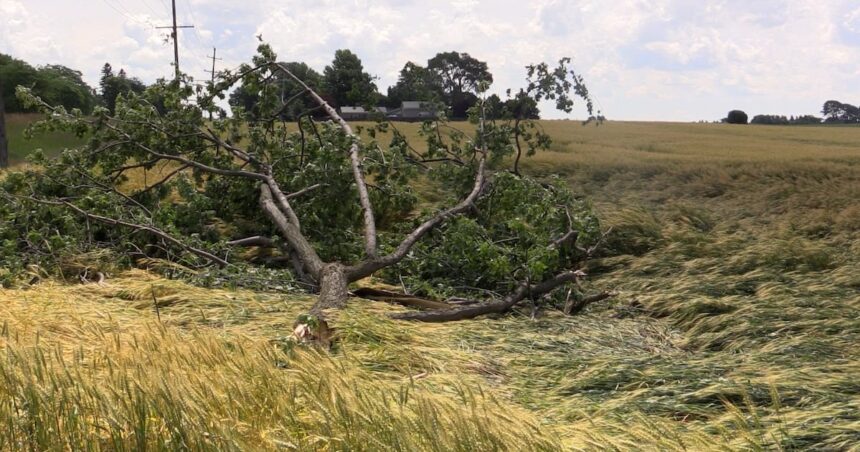A powerful tornado carved what researchers are calling a “very clear path” through farmland north of London, Ontario yesterday, leaving damaged buildings and downed power lines in its wake.
The Western University-based Northern Tornadoes Project confirmed the twister touched down near Lucan around 4:30 p.m., traveling northeast for approximately seven kilometers before dissipating. Initial assessments classify it as an EF-1 tornado with wind speeds reaching 150 km/h.
“The damage pattern shows classic tornado characteristics,” said Dr. Gregory Kopp, lead researcher with the Northern Tornadoes Project. “We’re seeing a narrow, concentrated path of destruction with counter-clockwise rotation evident in the debris field.”
Local farmer James Wilson was working in his equipment shed when the storm hit. “The sky turned this strange green color, and then everything went quiet for maybe thirty seconds. Next thing I knew, the wind picked up and the roof started lifting. I’ve never seen anything like it in my forty years farming this land.”
Environment Canada had issued a severe thunderstorm warning for Middlesex County shortly before the tornado formed, but many residents reported being caught off guard by the storm’s intensity.
“We had maybe five minutes between when my phone alerted me and when it hit,” said Lucan resident Marta Jankowski. “I grabbed my dog and we huddled in the basement. You could hear things hitting the house.”
Damage assessment teams from the Northern Tornadoes Project spent today documenting the destruction, which included several farm outbuildings, sections of forest, and at least two homes with significant roof damage. Hydro One crews worked through the night to restore power to approximately 1,200 affected customers.
“The tornado’s path crossed Provincial Road 4 near Roman Line,” confirmed Middlesex County Emergency Services Coordinator Paul Thompson. “We’re fortunate this happened in a relatively rural area and that we’ve had no reports of serious injuries.”
Ontario has seen an uptick in tornado activity in recent years. According to Environment Canada data, the province averages about 12-13 confirmed tornadoes annually, though many more likely go undetected in remote areas.
“Climate change is creating more atmospheric instability,” explained Western University meteorologist Dr. Sarah Chen. “We’re seeing conditions favorable for tornado development more frequently, particularly in this southwestern corridor of Ontario.”
The Lucan tornado marks the fifth confirmed in Ontario this season. Insurance Bureau of Canada spokesperson Vanessa Barrasa urged affected residents to document damage carefully and contact their providers promptly.
“Take photos before beginning cleanup, keep receipts for emergency repairs, and don’t dispose of damaged items until an adjuster has had a chance to assess them,” Barrasa advised.
Middlesex-London Health Unit issued precautionary guidance for those handling debris, recommending gloves, sturdy footwear, and tetanus boosters for anyone suffering puncture wounds during cleanup.
Local support mobilized quickly. The Lucan Community Centre opened as a temporary shelter, though most affected residents stayed with family or neighbors. Volunteer coordinators expect to organize cleanup crews this weekend.
“That’s just how we do things here,” said longtime Lucan resident Thomas MacPherson, who was helping clear a fallen maple tree from his neighbor’s driveway. “When something like this happens, everybody pitches in.”
The Northern Tornadoes Project will continue detailed analysis in coming days, using drone footage and on-the-ground assessments to refine their understanding of the tornado’s strength and behavior.
“Each tornado we study helps us better understand these dangerous weather events,” Dr. Kopp noted. “That knowledge ultimately improves warning systems and building codes, potentially saving lives in the future.”
Environment Canada meteorologists predict more unsettled weather for southwestern Ontario through the weekend, though they emphasize the specific conditions that spawn tornadoes remain difficult to forecast with precision.
“We’re entering peak tornado season for Ontario,” warned Environment Canada meteorologist Elena Trabucco. “Everyone should have a safety plan and pay close attention to weather alerts, particularly during afternoon thunderstorms.”
Provincial officials remind residents that emergency kits should include water, non-perishable food, flashlights, batteries, and a battery-powered radio to receive updates during power outages.






